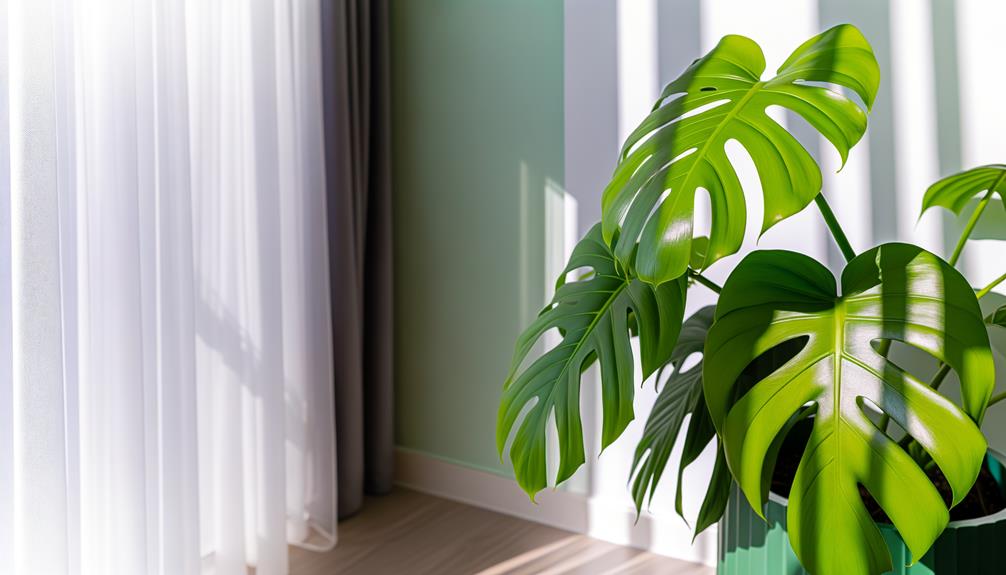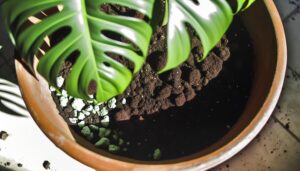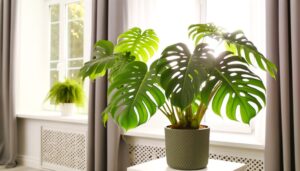Monstera Siltepecana Light Requirements
Place your Monstera Siltepecana in bright, indirect sunlight to replicate its natural forest canopy habitat. Avoid direct sunlight to prevent leaf scorch and maintain an ideal light intensity of 10,000 to 20,000 lux.
East or north-facing windows work best. Use sheer curtains to diffuse light, ensuring more balanced energy conversion.
In low light, you'll notice slower growth and less vibrant foliage. Consider full-spectrum LED lights positioned 12-24 inches above the plant for consistent light exposure, especially during winter.
If you see yellowing or browning leaves, you might need to adjust your light setup. Learn more about perfect conditions.

Key Takeaways
- Thrives in bright, indirect sunlight; avoid direct sunlight to prevent leaf scorch.
- Optimal light intensity is 10,000 to 20,000 lux for healthy growth.
- Position near east or north-facing windows for balanced light.
- Use sheer curtains to diffuse intense sunlight and protect leaves.
- Artificial light should be full-spectrum LEDs with 12-14 hour photoperiod.
Natural Light Needs

Monstera siltepecana thrives best when it receives bright, indirect sunlight for most of the day. This light condition mimics its natural habitat under the forest canopy, providing the photosynthetic energy it needs without the risk of leaf burn.
You should position your Monstera near east or north-facing windows, ensuring that direct midday sun doesn't reach it. The plant's chlorophyll pigments, especially chlorophyll a and b, effectively absorb light in the blue and red wavelengths, promoting robust growth. Additionally, diffused light supports the development of its characteristic fenestrations.
Insufficient light can result in etiolation, where the plant becomes leggy and weak. Therefore, maintaining consistent access to bright, indirect sunlight is essential for the Monstera siltepecana's health and vitality.
Ideal Light Intensity
When determining the best light intensity for Monstera Siltepecana, prioritize bright indirect light to facilitate best photosynthesis without leaf scorch.
Avoid direct sunlight, which can cause cellular damage and chlorophyll degradation.
While the plant can tolerate low light conditions, growth rates and foliage vibrancy will diminish.
Bright Indirect Light
Bright indirect illumination, characterized by high light strength without direct sun exposure, is essential for ideal Monstera Siltepecana growth and photosynthesis. This light condition guarantees prime chlorophyll activation, maximizing your plant's capacity to convert light energy into chemical energy.
Placing your Monstera near an east or north-facing window, or using sheer curtains to diffuse sunlight, achieves this specific requirement. Photons from indirect light penetrate effectively into the leaf tissues, promoting strong foliage and accelerated growth rates.
Monitoring light levels with a lux meter can help you maintain the recommended 10,000 to 20,000 lux range. Sustaining consistent bright indirect light nurtures vigorous photosynthetic activity, preventing etiolation and promoting lush, vibrant foliage.
Avoid Direct Sunlight
Maximizing your plant's growth involves avoiding direct sunlight, which can scorch Monstera Siltepecana's leaves and disrupt its photosynthetic efficiency. Direct solar radiation induces photoinhibition, reducing chlorophyll concentration and causing chlorotic lesions.
Ideal light intensity for Monstera Siltepecana is around 10,000 to 20,000 lux, achieved through diffused light sources or filtered sunlight. You should position your plant near east or north-facing windows where it receives gentle morning light or consistent ambient light throughout the day. Implementing sheer curtains or placing the plant slightly away from the window can help mitigate the risk of photodamage.
Monitoring leaf coloration and texture will provide cues about light adequacy. Following these guidelines maximizes your Monstera Siltepecana's robust growth and vibrant foliage.
Low Light Tolerance
Although Monstera Siltepecana can tolerate low light conditions, growth occurs at light intensities between 10,000 and 20,000 lux, which promotes healthy photosynthesis and vibrant foliage.
In subpar light, the plant's photosynthetic rate decreases, leading to elongated internodes and less robust leaves. You'll notice reduced chlorophyll production, resulting in a faded, less vibrant appearance.
It's essential to monitor light intensity using a photometer to guarantee your plant receives adequate illumination. If natural light is insufficient, consider full-spectrum grow lights that simulate the ideal conditions.
Proper light management ensures optimal energy conversion, fostering cellular respiration and nutrient uptake, essential for maintaining Monstera Siltepecana's health and aesthetic appeal.
Best Window Placement

When positioning your Monstera Siltepecana, place it near a window that provides ideal sunlight exposure without subjecting it to direct sunlight, which can cause leaf burn. East-facing windows are usually ideal, as they offer moderate morning light.
Additionally, adjust its placement seasonally to account for changes in light intensity and duration.
Optimal Sunlight Exposure
Positioning Monstera Siltepecana near a north or east-facing window provides the best balance of indirect sunlight essential for its growth. This plant thrives in conditions where it receives consistent, diffused light, which promotes prime photosynthesis without causing light inhibition.
The gentle morning light from an east-facing window offers adequate illumination while minimizing the risk of leaf scorch. Similarly, a north-facing window supplies steady, ambient light throughout the day. Maximize the plant is placed within one to two meters from the window to optimize light absorption while avoiding excessive exposure.
Utilizing sheer curtains can further diffuse direct sunlight, enhancing the plant's ability to capture light efficiently. This strategic placement supports vigorous foliage development and overall plant health.
Avoid Direct Sunlight
To prevent leaf scorch and other light-related damage, make sure your Monstera Siltepecana is never exposed to direct sunlight, which can cause irreversible harm to its delicate foliage. Place the plant near a window with filtered sunlight or indirect light.
North-facing windows are ideal, providing consistent, soft light without the intensity of direct rays. Alternatively, an east-facing window allows for gentle morning sun, minimizing risk. If only south- or west-facing windows are available, employ sheer curtains or blinds to diffuse the light.
Monitor leaf coloration and texture; any signs of bleaching or browning indicate excessive light exposure. Consistently shield your Monstera Siltepecana from harsh light to maintain its health and vibrant appearance.
Seasonal Light Changes
Understanding the impact of seasonal light changes on your Monstera Siltepecana's placement is crucial for maintaining ideal growth conditions year-round. During winter months, natural light intensity diminishes, necessitating strategic window placement to optimize light absorption.
Conversely, in summer, you must shield the plant from excessive direct sunlight to prevent chlorophyll degradation.
Consider these factors:
- Winter: Place near south-facing windows to maximize light exposure.
- Spring: Shift to east-facing windows for morning sunlight while avoiding midday intensity.
- Summer: Position away from direct sunlight; west-facing windows with sheer curtains work best.
- Autumn: Gradually reintroduce to brighter spots, mimicking spring placement.
- Year-round: Monitor light levels with a light meter, ensuring consistent 10,000 to 20,000 lux.
This nuanced approach guarantees optimal photosynthetic efficiency.
Effects of Low Light
In low light conditions, Monstera Siltepecana displays a significant reduction in photosynthetic efficiency, leading to stunted growth and chlorosis. You'll notice the leaves turning pale or yellow due to insufficient chlorophyll production.
The plant's internodes elongate, resulting in a leggy appearance as it stretches towards any available light source. Additionally, low light hinders the plant's ability to synthesize glucose, reducing overall importance and resilience. The root system may become underdeveloped, compromising nutrient uptake.
To mitigate these effects, monitor leaf coloration and growth patterns closely. Guarantee the plant receives adequate, indirect sunlight by placing it near a bright window, but not in direct sun, to avoid photoinhibition and potential leaf burn.
Using Artificial Lights

Artificial lights can effectively supplement natural light for Monstera Siltepecana, guaranteeing ideal photosynthetic activity and robust growth. You'll need to select the appropriate type of artificial light to mimic the plant's natural environment.
Light-emitting diodes (LEDs) are particularly efficient due to their energy-saving features and customizable light spectra. Consider the following factors for best results:
- Light Intensity: Aim for a Photosynthetic Photon Flux Density (PPFD) of 100-200 µmol/m²/s.
- Light Spectrum: Full-spectrum LEDs with a balance of blue (400-500 nm) and red (600-700 nm) wavelengths.
- Duration: Maintain a photoperiod of 12-14 hours daily.
- Distance: Position lights 12-24 inches above the plant.
- Heat Emission: Guarantee minimal heat output to prevent leaf scorch.
Seasonal Light Changes
As seasons shift, you'll need to adjust the light exposure for your Monstera Siltepecana to make it continues receiving ideal light intensity and duration for healthy growth.
During winter, natural daylight decreases in both intensity and duration. Position your plant closer to windows to maximize available light or supplement with grow lights emitting the full spectrum.
Conversely, in summer, the increased intensity can risk photodamage. Relocate the plant to a location with indirect light or use sheer curtains to diffuse the light.
Monitor photoperiodism; maintaining a consistent light schedule helps synchronize its physiological processes. Regularly assess the light conditions by measuring lux levels, aiming for 1000-2500 lux.
Adapting to seasonal changes ensures prime photosynthesis and robust growth.
Signs of Light Stress

Observing signs of light stress in your Monstera Siltepecana requires careful attention to indicators such as leaf discoloration, curling, or unusual growth patterns. These symptoms suggest that the plant's photosynthetic processes are disrupted, leading to suboptimal growth and health.
- Leaf Discoloration: Yellowing or browning may indicate either excessive light exposure or insufficient light.
- Leaf Curling: Edges curling inwards could signify too much direct sunlight, resulting in water loss.
- Unusual Growth: Stretched or leggy growth patterns often correlate with inadequate light, as the plant reaches for more light sources.
- Burn Marks: Brown, crispy spots typically result from intense, direct sunlight exposure.
- Slow Growth: Reduced growth rate frequently indicates the plant isn't receiving the appropriate light intensity.
Monitoring these signs guarantees your Monstera thrives.
Conclusion
To sum up, by understanding Monstera siltepecana's light needs, you can guarantee ideal growth and vibrant foliage. Remember, 'a plant well-lit is a plant well-fit.'
Prioritize natural light, but don't hesitate to utilize artificial sources if needed. Monitor seasonal changes and adjust accordingly.
Pay close attention to signs of light stress, like yellowing leaves or slow growth, and you'll cultivate a thriving environment for your Monstera siltepecana. Your plant's health hinges on these precise light conditions.






